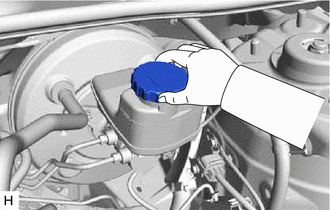Toyota Camry (XV70): Bleeding
BLEEDING
CAUTION / NOTICE / HINT
NOTICE:
- Move the shift lever to P and apply the parking brake before bleeding the brakes.
- Add brake fluid to keep the level between the MIN and MAX lines of the reservoir while bleeding the brakes.
- If brake fluid leaks onto any painted surface, immediately wash it off.
- Do not operate the brake actuator assembly while air is in the brake system or in the brake master cylinder sub-assembly. Doing so may cause air to enter the brake actuator assembly.
- If bleeding the brake actuator assembly is difficult due to air in the brake actuator assembly, replace it with a new one.
- When bleeding air, select the suitable procedure listed below.
Replaced/Installed Item
Work Procedure
Flexible hose (front/rear)
Bleed brake line
Disc brake cylinder assembly (front/rear)
Brake actuator assembly
Bleed brake system
Brake master cylinder sub-assembly
Brake master cylinder reservoir assembly
Brake booster assembly
HINT:
If any work is performed on the brake system or if air in the brake lines is suspected, bleed the air from the brake system.
PROCEDURE
1. BLEED BRAKE LINE
| (a) Remove the brake master cylinder reservoir filler cap assembly. |
|
(b) Add brake fluid to keep the level between the MIN and MAX lines of the reservoir while bleeding the brakes.
Brake Fluid:
SAE J1703 or FMVSS No. 116 DOT 3
SAE J1704 or FMVSS No. 116 DOT 4
NOTICE:
- Make sure that there is sufficient brake fluid in the reservoir.
- Do not remove the filter from the brake master cylinder reservoir assembly and be sure to fill the brake master cylinder reservoir assembly with new brake fluid to avoid any potential contamination of the brake system. Contamination, for example by dirt particles or mineral oil, could lead to functional brake problems.
(c) Remove the bleeder plug cap.
(d) Connect a vinyl tube to the bleeder plug.
(e) Depress the brake pedal several times, and then loosen the bleeder plug with the pedal depressed.*1
(f) When fluid stops coming out, tighten the bleeder plug and release the brake pedal.*2
(g) Repeat steps *1 and *2 until all the air in the brake fluid is completely bled out and new brake fluid comes out.
(h) Tighten the bleeder plug completely.
Torque:
8.3 N


